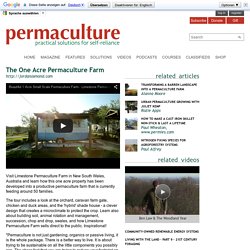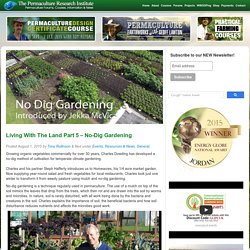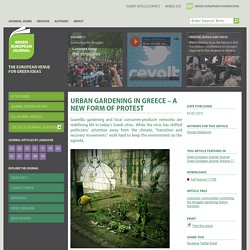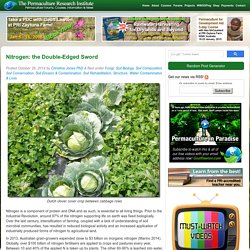

Facebook - Log In or Sign Up. Slow Food USA: Going Green: California Winemakers Lead the Way. This Swedish Couple Builds Greenhouse Around Home to Grow Food and Keep Warm Year Round. The average January temperature in Stockholm Sweden is 27 degrees Fahrenheit.

In this is cold weather it is expensive to heat the home and challenging to grow vegetables. As a solution to these issues, Charles Sacilotto and Marie Grammer created a massive greenhouse that encloses their home. They gave Fair Companies a tour of their “Naurhus” (aka Nature House) that is encompassed by a 4-millimeter pane of glass. The costs: $84,000 for the installation. The greenhouse home is heated by the sun during the day and keeps it warm in the evening due to residual heat that is stored in the bedrock that resides below the home. Spiritual farming with Steven Wynbrandt. Beyond Vegetarian: One Man's Journey from Tofu to Tallow in Search of the Moral Meal [Interview] - Dustin's View.
I met Daniel Zetah this past summer, while interning on a small-scale vegetable farm in northern Minnesota.
![Beyond Vegetarian: One Man's Journey from Tofu to Tallow in Search of the Moral Meal [Interview] - Dustin's View](http://cdn.pearltrees.com/s/pic/th/vegetarian-journey-interview-125104514)
He arrived one Thursday in a white, well-worn isuzu pickup, together with his fiancée, Stephanie. She's lived off grid alone for over 30 years - Page 2 of 2 - Homestead Notes. The One Acre Permaculture Farm. Visit Limestone Permaculture Farm in New South Wales, Australia and learn how this one acre property has been developed into a productive permaculture farm that is currently feeding around 50 families.

Search Results pallet. Living With The Land Part 5 - No-Dig Gardening. Growing organic vegetables commercially for over 30 years, Charles Dowding has developed a no-dig method of cultivation for temperate climate gardening.

Charles and his partner Steph Hafferty introduces us to Homeacres, his 1/4 acre market garden. Now supplying year-round salad and fresh vegetables for local restaurants, Charles took just one winter to transform it from weedy pasture using mulch and no-dig gardening. No-dig gardening is a technique regularly used in permaculture. The use of a mulch on top of the soil mimics the leaves that drop from the trees, which then rot and are drawn into the soil by worms and microbes.
In nature, soil is rarely disturbed, with all work being done by the bacteria and creatures in the soil. Urban gardening in Greece – A new form of protest - Green European Journal. The Greek crisis has radically changed Greek society, politics and the economy.

In just a few years the “Greek Dream” of the beginning of the 21st century, when Greece had experienced some years of rapid GDP growth (about 4% for the first 4 years of the new millennium) mainly due to construction and consumption, has turned into a nightmare. The Greek society is a society in great depression. What Cuba can teach America about organic farming. JUDY WOODRUFF: Now the conclusion to our series on Cuba.

All week long, we have showed you ways in which that country is dealing with significant shifts in business, arts, culture, and society. Tonight, Jeffrey Brown reports about an industry where Cuba has been a leader, organic farming. Its growth was born out of necessity. 4 Questions You Should Never Ask at Farmers Market. Stacey Carlberg of Potomac Vegetable Farms helps a customer at market.

I’ve spent over 1,000 Saturdays and Sundays selling at farmers markets, and even after all this time I still love to answer questions. Farmers markets are one of the few places where customers can directly connect with their food, meeting face-to-face with the people who grew it. Questions are expected at market, and even encouraged. From livestock breeds to production practices, organic certification to chemical usage, I’ve been asked just about every food-related question under the sun. Though most farmers will happily answer all inquiries, there are a handful of questions that make even the friendliest farmers want to choke a carrot. Nitrogen: the Double-Edged Sword. Dutch clover cover crop between cabbage rows Nitrogen is a component of protein and DNA and as such, is essential to all living things.

Prior to the Industrial Revolution, around 97% of the nitrogen supporting life on earth was fixed biologically. Over the last century, intensification of farming, coupled with a lack of understanding of soil microbial communities, has resulted in reduced biological activity and an increased application of industrially produced forms of nitrogen to agricultural land.
In 2013, Australian grain-growers expended close to $3 billion on inorganic nitrogen (Marino 2014). Globally, over $100 billion of nitrogen fertilisers are applied to crops and pastures every year. Impacts of inorganic nitrogen The application of high rates of inorganic nitrogen in agricultural systems has had many unintended negative consequences for soil function and environmental health. Perennial-farming-systems-organic-agriculture-edible-permaculture-eric-toensmeier-large-scale-farmland. To save the planet we may need to turn it into an edible paradise… help me write the book that explains how and why.

Check out my successfully funded kickstarter campaign to learn about this hopeful solution to climate change and how you helped make my book, The Carbon Farming Solution happen. Also please consider joining my mailing list. The following article appeared in the Fall 2011 and Winter 2012 issues of the Permaculture Activist. This is a companion piece to “Stabilizing the Climate with ‘Permanent Agriculture‘,” an article that appeared in the Spring 2011 issue of the Permaculture Activist. That article laid out the potential for perennial farming systems like agroforestry and perennial crops to sequester carbon while providing multiple social and ecological benefits. Perennial Staple Crops are basic foodstuffs that grow on perennial plants. Ricardo Romero of Las Cañadas in perennial staple food forest featuring peach palm, macadamia, air potato, banana, and perennial beans.